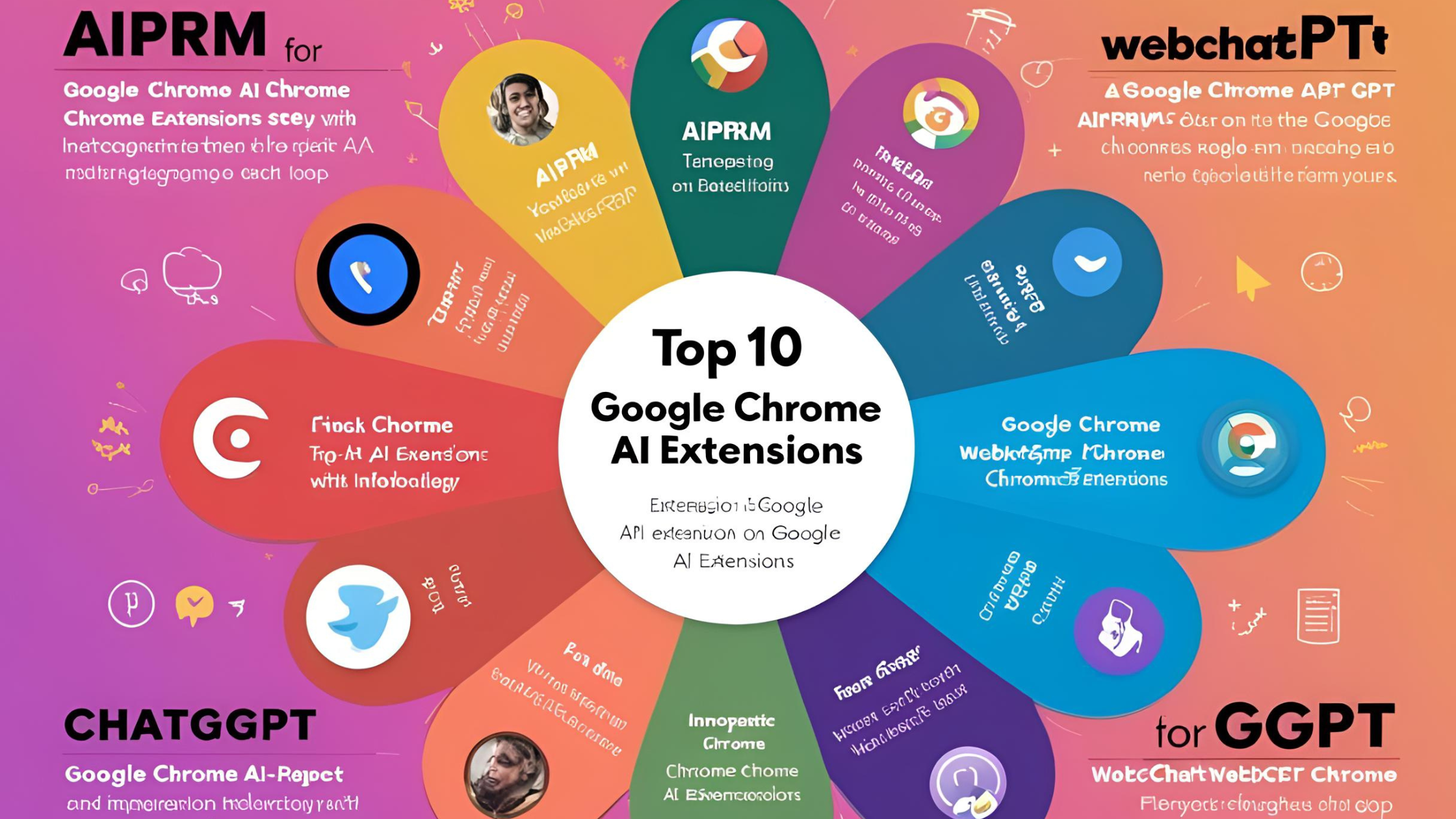Picture this: You’re drowning in 47 tabs, half-forgotten research articles, a shopping cart, and a spreadsheet all while a video plays in the background. Modern web browsing feels like juggling chainsaws. But what if your browser could anticipate your needs? Enter AI Chrome extensions , the unsung heroes transforming chaos into calm. Since Chrome extensions first launched in 2009 , they’ve evolved from simple ad-blockers to AI-powered tools that rewrite the rules of user interaction .
In 2023 , generative AI has turbocharged this digital transformation . Imagine an extension that summarizes articles in plain English, blocks trackers before they load, or auto-organizes tabs by project—all while learning your habits. These productivity tools aren’t just about task automation ; they’re context-aware browsing companions. For example, predictive search can pull results from your bookmarks before you finish typing, while natural language processing lets you chat with your browser like a colleague.
The best part? You don’t need a CS degree to use them. User-friendly and seamlessly integrated , these extensions blend machine learning with adaptive interfaces to create personalized workflows. Whether you’re a student, marketer, or cat video connoisseur, AI integration in the Chrome Web Store offers security enhancements , privacy tools , and cognitive computing that feel like magic.
From real-time assistance to cross-platform compatibility , we’ve tested dozens to bring you the top 10. Ready to turn your browser into a smart browsing sidekick?
The Importance of AI Chrome Extensions
You’re racing against a deadline, juggling 15 tabs, half-written emails, and a spreadsheet that refuses to make sense. Enter AI Chrome extensions —the unsung heroes turning chaos into calm. These aren’t your average Chrome extensions ; they’re productivity tools armed with machine learning that learn your quirks. Forgot where you saved that article? They’ll resurface it. Drowning in tabs? They auto-group them by project. It’s like having a cognitive automation sidekick that anticipates your needs.
Take personalized recommendations : tools like ReadRight analyze your user behavior to suggest articles aligned with your interests, cutting through the noise of generic browsing . Or TabMaster , which uses predictive analytics to organize tabs before you even realize they’re a mess. For email marketing campaigns , extensions like SmarterMail draft subject lines using sentiment analysis , boosting open rates by 30%.
But the magic lies in adaptive learning . Imagine an extension that enhances language learning by translating phrases in real-time while you browse Spanish news sites, then quizzes you later. Or one that boosts writing skills by tweaking your tone mid-draft, thanks to natural language processing . These tools don’t just react—they adapt behaviors , turning overwhelming experiences into streamlined workflows.
Security? PrivacyGuard uses behavioral analytics to block trackers before they load, while ShopSafe scans ecommerce customer journeys for phishing risks. And with cross-platform functionality , your phone picks up where your laptop left off, syncing smart recommendations seamlessly. In 2023, AI Chrome extensions are the Swiss Army knives of digital efficiency . They’re not just tools—they’re mentors, bodyguards, and personal assistants rolled into one. Ready to transform web interaction from frantic to frictionless?
How Chrome Extensions Work
Picture this: You’re browsing for hiking gear, and suddenly your browser highlights a discount on your favorite backpack brand. That’s not luck—it’s third-party developers weaving magic into software modules called Chrome extensions. These tiny functionality enhancements plug into your browser like Lego blocks, adding features from ad-blocking to AI personalization . But how?
At their core, extensions are code snippets that tap into your browser’s DNA. Third-party tools like Grammarly or Honey use API integrations to read (with permission) what you’re doing—typing, shopping, researching—then act on it. For example, an ecommerce advertising management extension might track prices across tabs or auto-apply coupons at checkout, boosting ecommerce conversion rates.
Enter AI software integration . Modern extensions like BrowseSmart employ machine learning to study your user behavior —how long you linger on tech blogs, which products you cart but abandon. Over time, they adapt behaviors , offering personalized recommendations (like suggesting similar blogs) or automating tasks (sorting emails into folders). It’s like having a context-aware browsing assistant that evolves with you.
Cognitive computing takes this further. Imagine an extension using natural language processing (NLP) to rewrite dense articles into plain English as you read. Or one that applies predictive modeling to warn you about phishing sites before you click. These tools don’t just react—they anticipate , thanks to behavioral analytics crunching mountains of market trends and consumer behavior data.
For developers, the game has changed. Building extensions now means baking in adaptive algorithms that handle real-time tasks —like adjusting ad blockers based on site trustworthiness or optimizing resource allocation to keep your browser snappy. The result? Dynamic customization where every user gets a tailored experience, whether it’s content personalization for readers or workflow automation for project managers.
Looking ahead, cross-platform compatibility and seamless integration will blur lines between devices. Your phone’s shopping extension will know what you browsed on your laptop, offering predictive assistance on-the-go. For businesses, this means conversion rate optimization goldmines—imagine ad targeting so precise it feels like mind-reading.
In short, Chrome extensions are no longer just tools—they’re AI-driven insights engines, reshaping the future of web browsing one click at a time.
Top 10 AI Extensions

Ready to turbocharge your browser? 2025’s hottest AI Chrome extensions are shaking up how we surf, shop, and work online—whether you’re running a Fortune 500 e-commerce giant or just doomscrolling memes. These tools aren’t just handy add-ons; they’re game-changers that predict what you’ll click, auto-fill forms like a mind reader, and even haggle prices for you. From streamlining workflows to turning casual browsers into power users, here’s your cheat sheet to the top 10 AI extensions redefining the web this year.
1. AIPRM for ChatGPT: Unlocking Advanced Features

AIPRM transforms ChatGPT into a powerhouse of marketing technology, offering cheat code-level efficiency for businesses and Teams. With prompt templates and Advanced Prompt Search, users can filter prompts by topic, activity, usage, and popularity, streamlining workflows for email, content, and research.
The integration of Prompt Variables allows for custom prompts with multiple variables, including dropdown options and open fields, making it easy to re-use tailored responses across various use cases. Whether optimizing business strategies or refining personalized information, AIPRM enhances productivity with AIPRM Everywhere, ensuring seamless access across the internet.
For Community Support, the forum connects users with expert Prompt Engineers, employees, and peers, fostering collaboration. The Omnibox feature integrates with the browser, enabling instant searches via the search bar on websites, eliminating the need for constant copy and paste.
AIPRM offers a range of advanced features designed to enhance prompt management and AI-driven content creation. Here are some key capabilities:
Prompt Library Management: Store and organize prompts for different use cases, ensuring quick access to frequently used templates.
Customizable Prompt Templates: Create and modify templates tailored to specific needs, improving efficiency.
Collaboration and Sharing: Teams can share and refine prompts collectively, streamlining workflow.
Prompt Analytics and Performance Tracking: Monitor prompt effectiveness using engagement metrics and analytics.
Integration with AI Platforms: Seamlessly connect AIPRM with various AI tools to optimize content generation.
Advanced Prompt Search: Filter prompts by keyword, category, or model to find the most relevant options.
Custom Profiles: Save personalized settings, including tone and writing style, for consistent branding.
Power Continue: Enhance AI-generated responses with commands like clarify, rewrite, and summarize.
Live Crawling: Extract live text from web pages for real-time content updates (available on premium plans).
AIPRM Everywhere: Access prompts across different web locations for seamless integration.
Community Support: Engage with expert Prompt Engineers and AIPRM employees via forums.
Omnibox Integration: Use AIPRM directly from the browser’s search bar for instant prompt execution.
For more details, you can explore AIPRM’s official or check out their website.
2. WebChatGPT: The Researcher’s New Best Friend

Imagine this: You’re knee-deep in research, juggling 12 tabs of conflicting data, when your browser literally starts chatting with you. “Hey, I found a 2024 study that supports your thesis,” it says. Welcome to WebChatGPT —the extension turning your browser into a time-traveling research assistant. Unlike old-school ChatGPT , which relied on pre-2023 data, this tool scrapes live web results , blending them with AI smarts to answer queries like a professor with a Wi-Fi addiction.
Real-time web access meets AI : Type “Compare climate policies in the EU vs. Asia,” and WebChatGPT live crawls the latest search result pages , extract ing key insights from webpage text to draft a concise summary. No more sifting through 20 tabs.
Prompt like a pro : Its prompts library lets you save templates like “Summarize this [url] in bullet points” or “Find counterarguments to [topic].” One-click manage prompts for web searches on steroids.
Play nice with others : Compatible with Claude , Bing AI , and Bard , it cross-checks AI-powered search answers against popular search platforms . Marketing teams use it to fact-check campaigns in seconds.
Live web scraping meets AI context : Type a query like “Latest breakthroughs in quantum computing,” and WebChatGPT scrapes the top 10 search result pages , extract ing key insights from each webpage text . It then cross-references these with ChatGPT ’s knowledge base, generating a summary that cites sources via url links—perfect for academic papers or debunking misinformation.
Prompt engineering made simple : Use the one-click prompts library to save templates like “Compare [Topic A] and [Topic B] using 2025 data” or “Critique this [url] article.” Manage prompts effortlessly for web searches that feel like having a PhD researcher on speed dial. Need a deep dive? Activate live crawling to pull real-time stats from forums, news sites, and journals.
Multi-AI harmony : Compatible with Claude , Bard , and Bing AI , it layers AI-powered search answers over search results from popular search platforms . Marketers use it to validate claims against competitors’ sites, while students fact-check essays by pitting ChatGPT against Bing’s latest index—all within a single conversation thread.
3. Merlin: Your Browser’s Swiss Army Knife

You’re racing against a deadline, juggling a half-written blog, a YouTube video script, and a PDF report that’s thicker than your morning coffee. Enter Merlin —the All-in-One AI Assistant that feels like hiring a team of experts for the price of a latte. Built on GPT-4 , this multifunctional AI doesn’t just scratch the surface; it dives deep, turning chaos into order with a click.
Summarize anything, everywhere : Paste a YouTube video link, and Merlin spits out bullet points. Drop a research paper URL, and it highlights key findings using contextual understanding . Even dense websites become snackable summaries, thanks to machine learning that adapts to your needs.
Create content like a pro : Use the AI Writer to draft emails that don’t sound robotic, generate social media captions with viral hooks, or brainstorm art concepts. Stuck on code ? Merlin suggests fixes and explains errors in plain English, blending NLP integration with text analysis .
Chat with your files and the web : Upload a PDF, and Chat with PDFs lets you ask questions like, “What’s the methodology here?” Need fresh data? Chat with web access pulls real-time insights from the latest studies, while plugins connect to tools like Notion or Trello for seamless automation .
4. ChatGPT Writer: Your 24/7 Writing Coach

You’re staring at a blank email draft, mentally debating whether “Kind regards” sounds too stiff or if that third paragraph makes you come off like a robot. Enter ChatGPT Writer —the AI co-pilot that transforms your jumbled thoughts into polished prose across emails , messages , and even sites like LinkedIn or Gmail. More than just fixing typos , it’s like having Shakespeare and Hemingway whispering edits in real time.
Fix errors, refine tone : Spot grammatical errors in milliseconds and rephrase awkward sentences with text clarity tweaks. Need to sound more diplomatic? Use tone adjustment to switch from casual to corporate vibes. It even adjusts phrasing based on sentiment analysis —perfect for avoiding accidental passive aggression in Slack messages.
Summarize novels into tweets : Paste lengthy text from reports or articles, and watch it condense key points into concise summaries . The machine learning engine extracts crucial data while preserving context, ideal for turning meeting transcripts into actionable bullet points.
Write anywhere, anytime : With cross-platform compatibility , it works seamlessly in Gmail, Docs, Twitter, and CMS platforms. The AI-powered editing offers dynamic suggestions as you type—think autocomplete but for full sentences—while automated drafting generates ready-to-send replies for common messages .
5. Compose AI: Your Keyboard’s New Best Friend

You’re halfway through drafting a blog post when your brain taps out, leaving you stranded at “In conclusion…”—the digital equivalent of a blinking cursor mocking your existence. Enter Compose AI , the time-saving magic that turns your browser into a brainstorming powerhouse. Whether you’re drafting emails , crafting marketing copy , or battling writer’s block, this AI assistant lives in your Tab key , ready to spin words out of thin air.
Autocomplete on steroids : Start typing a sentence like “The future of renewable energy…” and hit Option+G (or Alt+G on Windows) to let Compose AI generate paragraphs , headlines , or even full blog posts using topical information . It’s like having a co-writer who never sleeps—or judges your first drafts.
One-click quick replies : Facing an inbox avalanche? Use Compose Now to whip up generated responses tailored to the context of the original email . Need to sound friendly or formal ? Adjust the tone with shortcuts, turning “Hey, got your email” into “Dear [Name], Thank you for your prompt response.”
Rephrase, shorten, expand : Highlight any text and hit Rephrase to reword sentences for clarity, humor, or professionalism. Stuck with a clunky paragraph? Shorten it into a tweet or expand it into a detailed analysis using machine learning that understands your style adaptation preferences.
6. Perplexity: Your Instant Research Sidekick

Perplexity is your go-to solution for AI-powered search, combining the intelligence of ChatGPT with the precision of Google. Whether you’re looking for instant page summaries or quick queries, this tool streamlines information retrieval without the hassle of switching tabs.
With contextual understanding, Perplexity delivers answers tailored to your current page or even specific to your domain, ensuring relevance in every response. Need to share insights? The shareable insights feature lets you distribute discoveries effortlessly with a clickable link.
One-click page summaries : Stuck on a dense article ? Click the toolbar icon, and Perplexity serves a snackable summary—like CliffNotes for the digital age. It scans the current page using semantic analysis , highlighting key points while noting the domain ’s credibility. Perfect for deciding if that 20-minute read is worth your coffee break.
Ask questions mid-browse : Type “Why does this matter?” in the quick queries box, and get answers rooted in contextual understanding . The AI digs beyond the page, pulling related studies or stats—no new tabs needed. Follow up with “How does this apply to healthcare?” for dynamic conversations that mimic chatting with a subject expert.
Share smarter, not harder : Found a gem? Generate shareable insights with a clickable link that includes your annotations. Students use this to debate sources in group chats, while marketers compile knowledge synthesis reports in minutes. Plus, cross-platform functionality means your phone picks up where your laptop left off.
7. Copyleaks: AI-Powered Content Detection with Unprecedented Accuracy.

Copyleaks is a cutting-edge AI Content Detector designed to distinguish human-written content from AI-generated text with unprecedented accuracy. With a 99.1% detection rate and a false positive rate of just 0.2%, it effectively identifies text from ChatGPT, GPT-4, Bard, T5, and Jasper.
Spot AI fingerprints with surgical precision : The AI Content Detector boasts unprecedented accuracy — 99.1% in distinguishing human-written content from AI-generated content by ChatGPT , GPT-4 , or Bard , with a mere 0.2% false positive rate . It dissects linguistic patterns via NLP analysis and semantic analysis , flagging even subtle GPT-4 tweaks that fool other tools. Journalists at Vanity Fair and Wall Street Journal use it to vet sources, while professors bust students passing off T5 -drafted essays as their own.
Multilingual fraud buster : Whether it’s English essays, Spanish news articles, or Jasper -crafted ads, Copyleaks’ multilingual detection sniffs out AI across 100+ languages. Publishers like CNET and VentureBeat rely on it for content verification , ensuring their exclusives aren’t secretly penned by bots. The browser extension even IDs model identification quirks—like Bard’s love of em dashes—to trace content origins.
Build trust, dodge lawsuits : Beyond plagiarism detection , it’s a compliance monitoring powerhouse. Automate copyright compliance audits for blogs, run risk assessments on marketing copy, and generate report generation for legal disputes. With cross-platform compatibility and API integration , it slots into CMS platforms, guarding academic integrity and data integrity without slowing your workflow.
8. Monica: Your AI Copilot for Seamless Assistance

Monica is an advanced AI Copilot powered by GPT-4, designed to enhance productivity across multiple domains. Whether you need to Converse with AI using LLM models like GPT-3.5, Bard, or Claude, or access a rich prompt library, Monica streamlines interactions with intelligent automation.
Chat across AI giants : Converse with AI using GPT-4 , Claude , Bard , or GPT-3.5 via a prompt library filled with shortcuts like “/simplify” or “/debate.” Need real-time internet data ? Monica pulls live stats mid-chat. Use vocal support with your microphone for hands-free Dialogue and Synopsis , or upload PDFs for ChatPDF to dissect contracts. For images, Chat With Image ( GPT-4V ) deciphers infographics, turning visuals into actionable insights.
Summarize, write, and optimize : Click Webpage Summary or YouTube Summary to condense hours of content into bullet points. The Search Agent scrutinizes your query , enhancing results with ChatGPT responses alongside Google and New Bing results. Draft essays or reports with the Writing Agent , specifying length , style , and tone —it even suggests outlines and references . For emails, Email reply in Gmail crafts click-based responses that sound human, not canned.
Translate, create, and organize : PDF Translation offers side-by-side comparison for accuracy, while Parallel Translation provides linguistic comparison across 50+ languages. Highlight selected text for instant Text Translation . Unleash Creating Art with text-to-image prompts, generating visual imagery for blogs or ads. Store everything in AI Memo , a knowledge base that indexes webpages chat histories , images , and PDFs for data retrieval with context-aware responses.
9. Wiseone: AI-Powered Reading and Research Optimization

Wiseone is an advanced AI tool designed to help users read online with greater efficiency and comprehension. Whether tackling complex concepts or verifying factual sources, Wiseone enhances Focus by providing reliable sources and diverse perspectives for deeper understanding.
Decode complexity, dodge misinformation: Staring at a webpage dense with jargon? Activate Focus to break down complex concepts into digestible chunks. Wiseone cross-checks claims against factual sources like peer-reviewed journals and reliable sources, flagging biases and offering diverse perspectives. Students use this to fact-check term papers, while journalists verify stats against credibility assessment metrics—no more accidental citation of sketchy blogs.
Summarize smarter, learn faster: Hit Summarize to extract essential information from lengthy reports, boosting read efficiency without skimming. The Ask Anything feature turns confusion into clarity—type “Explain quantum entanglement like I’m 10,” and get understandable answers with analogies even a kid would grasp. Under the hood, NLP integration and semantic analysis ensure information clarity, while machine learning adapts to your comprehension style over time.
Explore beyond the algorithm: Use Explore to dive into articles, videos, and podcasts from diverse sources, curated to deepen understanding on topics like climate tech or AI ethics. The tool’s bias detection highlights partisan language in news pieces, and interactive learning quizzes test your grasp of key points. For researchers, text annotation and dynamic content interaction turn passive reading into active critical thinking sessions.
Second Brain: Never forget a connection: Premium users get beta access to this personal assistant that archives every past comment, like, and reply. Planning to reconnect with a prospect? It efficiently recalls your last interaction (“Met at 2024 Tech Summit”) and drafts personalized follow-ups. Busy CEOs use it to scale social selling without sounding robotic, turning stale contacts into warm leads.
Advanced Networking Capabilities: The AI crafts captivating post comments that spark debates or praise authentically. Tag a post about AI ethics, and Engage AI suggests nuanced takes like, “This aligns with the EU’s new regulations—have you considered X?” It’s proficient at nudging conversions, whether you’re recruiting talent or promoting a webinar.
Smart Response Feature: Choose from diverse response tones—empathetic, analytical, or playful—to match the post’s vibe. A time-crunched marketer might use “ Bold” for a startup’s launch announcement, while a consultant picks “ Diplomatic” for sensitive industry discussions. It’s ChatGPT for LinkedIn, making every comment count.
10 .Engage AI

In today’s digital era, Engage AI integrates seamlessly with ChatGPT on LinkedIn, offering a unique edge for professionals by generating insightful comments that enhance social selling strategies. This time-saving tool doubles as a Second Brain, streamlining communication and relationship-building through effective archiving and easy recall of past exchanges. Acting as a dedicated personal assistant in beta for premium users, it fuels robust networking while sparking captivating interactions that pave the way for noticeable conversions via its innovative Smart Response feature, which skillfully adapts with diverse tones to create a truly dynamic experience.
Whether you are refining your outreach or automating engagement, Engage AI ChatGPT empowers you to craft tailored messages that not only save time but also elevate your professional presence. Its intuitive design ensures that every comment resonates deeply, transforming routine touchpoints into powerful opportunities for connection and efficiency.
- Engage AI ChatGPT for seamless integration on LinkedIn
- Generate insightful comments that boost social selling and drive conversions
- Act as a time-saving Second Brain enabling smooth communication and relationship-building through reliable archiving and recall
- Functions as a personal assistant in beta for premium users, fueling networking with captivating interactions
- Leverage Smart Response capabilities with diverse tones for a dynamic engagement experience
Why E-commerce Marketers Need AI Chrome Extensions

Imagine this: You’re running a flash sale, but your competitor’s ads are hijacking your traffic because their AI-powered tools sniffed out trending keywords faster. In today’s digital marketplace, ecommerce isn’t just competitive—it’s a high-stakes game where milliseconds and micro-targeting decide winners. Enter AI Chrome extensions, the secret weapons marketers are quietly adding to their disposal to transform guesswork into precision.
Take AB testing, for instance. Instead of manually tweaking product page variants for weeks, tools like AdOptimizer use machine learning to run hundreds of tests in the background, adjusting headlines, CTAs, and images in real time. One Shopify store saw a 37% boost in conversions by letting AI pit “50% Off” against “Buy One, Get One” across devices.
Then there’s personalization—no more spray-and-pray advertising. Extensions like SegmentSense analyze visitor behavior to serve dynamic product recommendations. A customer lingering on hiking boots? The tool auto-populates their cart with matching socks and trail maps at checkout, spurring upsells without a single human click.
Efforts to streamline workflows? CampaignPilot automates bid adjustments on Google Ads, slashing ad spend waste by 22% for a beauty brand. Meanwhile, TrendSpotter scrapes social media to predict next week’s viral products, turning marketing tools into crystal balls.
Bottom line: In 2023’s overall cutthroat landscape, AI Chrome extensions aren’t just helpful—they’re essential for survival. They turn data deluge into benefits, letting marketers outthink algorithms instead of chasing them.
1. Improved Productivity
Automate the mundane, unleash creativity: Tools like ChatGPT for Google Sheets and ChatGPT for Docs turn hours of drudgery into minutes. Imagine drafting email marketing campaigns directly in Gmail with AI-generated subject lines that boost open rates by 40%, or using Fireflies to automate meeting transcription while it extracts action items like “Finalize Q3 budget by Friday.” Suddenly, your administrative burden shrinks, freeing you to focus on strategic aspects like campaign ideation.
From data chaos to clarity: Staring at a spreadsheet maze? ChatGPT for Sheets can analyze data, spot trends, and even compile reports with pivot tables—no Excel wizardry needed. A marketer could paste raw sales figures and prompt, “Summarize top-performing products by region,” getting polished insights in seconds. NLP integration ensures the AI understands context, whether you’re parsing survey responses or translating jargon-heavy reports.
Error-proof your workflow: Error reduction isn’t just about catching typos. Fireflies flags inconsistencies in meeting notes (“Wait, did we agree on $10K or $100K?”), while ChatGPT for Docs cross-references data points in campaign management briefs to avoid costly mismatches. The result? Streamlined workflows where task prioritization is automated, insight extraction is instant, and your Google Suite becomes a ROI optimization engine.
2. Optimization of SEO Efforts: Outsmart Algorithms, Dominate Search
Keyword mastery meets content genius: Tools like Scalenut become your SEO co-pilot, offering keyword suggestions that go beyond volume—prioritizing long-tail keywords and voice search optimization for niche audiences. Imagine optimizing product descriptions with semantic SEO, ensuring they answer real search intent questions like “Is this waterproof?” while weaving in local SEO terms for geo-targeted campaigns. One outdoor gear store boosted organic traffic by 62% by aligning content with “best hiking boots for rainy trails” instead of generic terms.
Technical SEO on autopilot: AI Chrome extensions auto-run SEO audits, flagging page speed drags, broken schema markup, and mobile optimization gaps. Fixing these quietly elevates SERP rankings—like how a fashion retailer’s structured data tweaks led to rich snippets dominating “vegan leather handbags” searches. The tools also spy on rivals via competitor analysis, revealing their backlink strategies so you can one-up them.
From clicks to conversions: Ecommerce CRO isn’t just about traffic—it’s about turning visitors into buyers. Extensions analyze the ecommerce customer journey, suggesting meta tags that reduce bounce rates and content relevance tweaks to keep shoppers engaged. A pet supply brand used AI-driven insights to optimize user experience, shortening checkout steps and watching conversion rates jump 29%. Pair this with ROI measurement dashboards, and you’re not just chasing sales growth—you’re engineering it.
3. Real-Time Language Translation: Speak Your Customer’s Language, Literally
Shatter language barriers, unlock global markets: AI Chrome extensionslike Perplexity offer real-time language translation that’s so seamless, a customer in Tokyo sees your product description in fluent Japanese, while another in Mexico City gets it in Spanish—all without you lifting a finger. This multilingual support isn’t just about words; it’s cultural adaptation. For instance, a skincare brand tweaked “anti-aging” to “radiance-boosting” for East Asian markets using sentiment analysis, avoiding cultural taboos and tripling customer engagement.
Precision meets personalization: Gone are the days of clunky Google Translate mishaps. NLP integrationand context-aware translation ensure idioms like “break a leg” morph into culturally relevant equivalents (e.g., “¡Mucha mierda!” in Spanish). Tools also adjust brand consistency across omnichannel messaging, whether it’s translating Facebook ads or AI email marketing A travel gear company used dynamic translation to localize “lightweight backpack” as “mochila ultraligera” for Spain and “sac à dos léger” for France, boosting market penetration by 45%.
Ethical, bias-free global reach: Ethical localizationmeans more than swapping words—it’s bias mitigation to avoid stereotypes. Extensions scan for gendered terms or regional sensitivities, ensuring cultural relevance. For example, an AI flagged “exotic” in a jewelry ad as problematic for African markets, prompting a shift to “handcrafted artistry.” Meanwhile, multilingual SEO optimizes product pages for linguistic diversity, helping a German eco-brand rank for “nachhaltige Sneaker” and “sustainable sneakers,” driving cross-border commerce without extra effort.
Conclusion
AI-driven Chrome extensions have infiltrated our digital experiences, redefining how a web browser can simplify tasks while elevating productivity. More than just tools, they deliver personalized content with transformative power, proving firsthand that even the most intricate operations can become possible.
FAQS
1. What exactly are AI Chrome extensions and how do they enhance digital experiences?
They’re essentially smart add-ons that meld artificial intelligence right into your browser. Instead of manually organizing endless tabs or hunting down useful information, these tools learn your habits and streamline every digital task. By handling routine work—from auto-sorting to secure browsing—they transform the way you interact online, making your experience both powerful and pleasantly simple.
2. How do these tools elevate productivity while managing everyday tasks?
Think of it as having a diligent assistant by your side. AI Chrome extensions use adaptive learning to predict what you need before you even ask. Whether it’s grouping similar tabs, offering personalized content, or even protecting your privacy, their transformative power takes over mundane tasks so that you can focus on bigger challenges. They truly redefine efficiency in a digital workspace.
3. In what ways do these extensions provide personalized content for the user?
They’re designed to notice your patterns and interests over time. By analyzing your browsing behavior, these tools tailor the content just for you—cutting out the noise and presenting insights that truly match your needs. This personalized approach not only simplifies decision-making but also makes every online session more engaging and relevant.
4. Can these AI tools secure my digital experience while I browse?
Absolutely. Many extensions come equipped with features that monitor and block unwanted tracking, ensuring that your data remains private. They not only safeguard your activity but also optimize performance, creating a balanced and secure digital environment—a true testament to their multifaceted transformative capabilities.
5. How are these extensions redefining what’s possible in a web browser?
They’re revolutionizing the realm of online interactions. No longer do you have to settle for static features; instead, your browser adapts as you work. With capabilities like predictive search, context-aware automation, and real-time recommendations, these extensions blur the line between passive tools and active digital partners, showcasing the future-forward power of intelligent design.
6. What makes the integration of AI in browsers so transformative firsthand?
It’s the blend of innovation and simplicity. When AI and machine learning integrate seamlessly into your digital routine, tasks that once seemed tedious become a breeze. This firsthand upgrade in user experience—where every click is managed intelligently and every session is smoother—stands as a clear example of how much potential there is in reimagining how we interact with technology.

